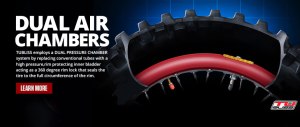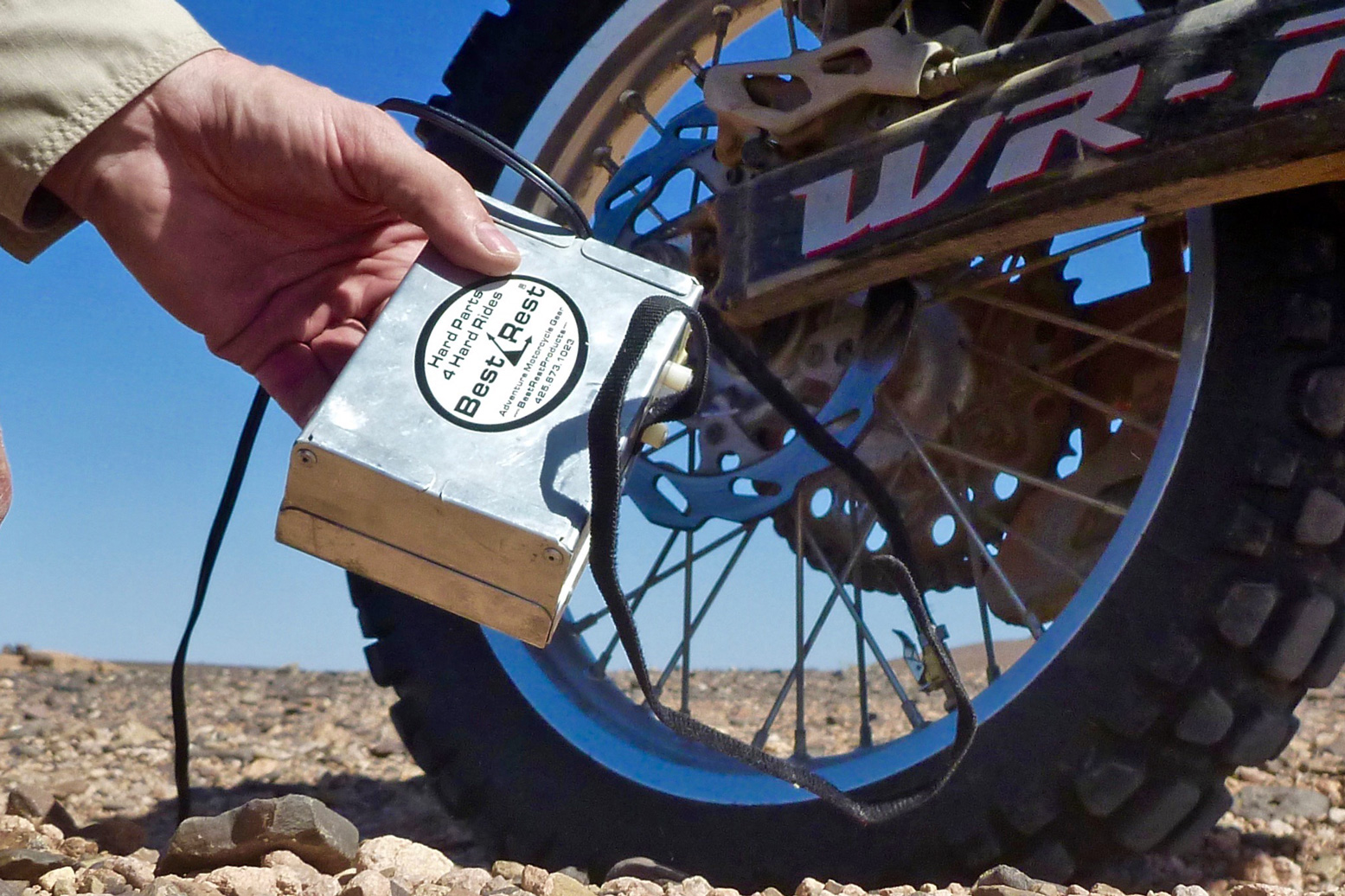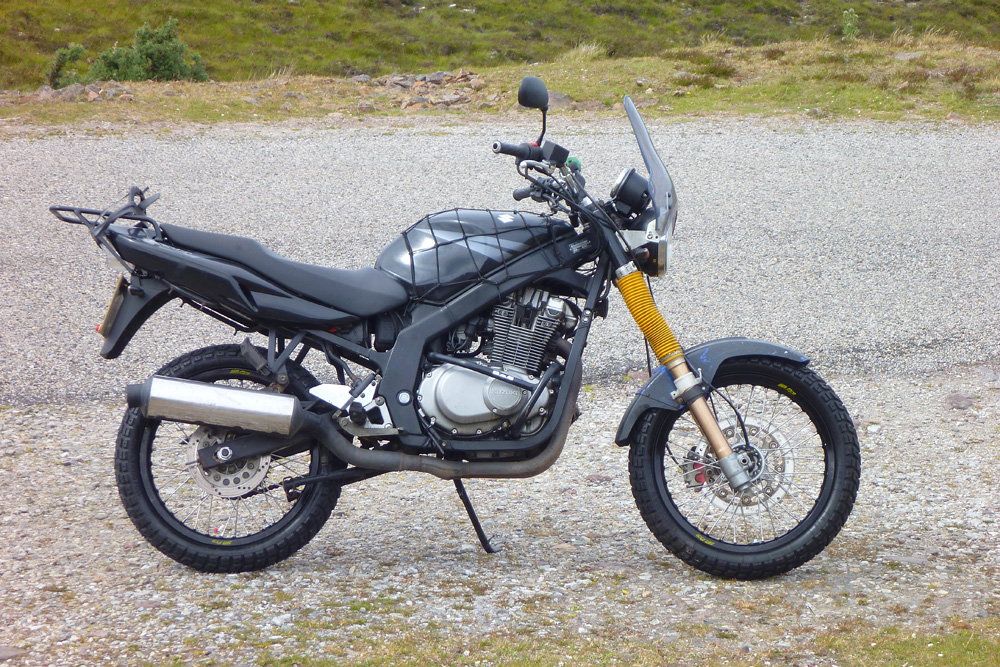Updated 2020
Tubeless Conversion Index Page
GS500R Index Page Himalayan Index Page
Tubliss Generation 2 is now widely available in 18, 19 and 21-inch sizes for WM3 (2.15”) or slimmer rims. I fitted one to the front of my Himalayan

My Suzuki GS-R ran 19-inch SM Pros and the plan was always to have them running tubeless, hopefully doing a more successful job than I did on my Tenere’s wheels a couple of years earlier. On that bike the sealed-up rear never missed a beat, but the 21-inch front leaked off-road and as I failed to monitor it, it got soft enough to ding a rim on a gnarly Moroccan climb and with that lose all pressure.
Back then I wanted to try Tubliss but they weren’t sold in Tenere sizes in the UK. I picked some up in the US for around £55 each. The vid below explains it all very loudly. Man that guy can talk!
I was expecting a hard time fitting them in my Heidenau K60s – it’s a stiff tyre and you’d imagine the bulk or shape of the red plastic core and rim-lock might make tyre mounting even harder. When a sunny afternoon came by, I left the 4000-mile old K60 out against a wall to warm up a bit and then followed the clear instructions carefully. Off with the old Cheng Shin without too much difficulty, clean off the duct tape/rim tape residue and the drill an 11mm hole a few spokes up from the regular valve hole. I then talc’ed the inside of the red liner to slide better against its mini tube, lined up the rim lock clamp/tyre inflation valve and the nearby core inflator valve with the two holes in the rim (pic above; the instructions stress this is critical) and then mounted the core onto the rim.

 How it works
How it works
Tubliss works by using a small but extra thick bicycle-sized inner tube at very high pressure to expand the red casing onto the tyre’s bead, sealing it against the rim (see image below). By doing so it isolates the tyre’s main air chamber from the spoke nipples where air would otherwise slowly leak out.
This can be an odd concept to get your head around; a high-pressure mini-tube is still used to press and seal the tyre bead against the rim, but the tyre chamber itself is effectively tubeless. An additional hole for a rim lock is required so as to pin down the red casing and completely eliminate tyre slip and valve lean at low pressures (as happens with regular tubes at low psi). Because the thick Tubliss mini tube isn’t anywhere near the flexing tyre carcass and is inside the red casing, it would take an exceedingly long and sharp spike to puncture it. Plus everything remains cooler; the benefit of all tubeless tyres. You can still tune spokes, something not be so easily done with other spoke nipple-sealing methods. The rim lock uses a ‘hollow bolt’ which is also a valve to inflate the tyre chamber to a regular pressure. The original valve hole is used to inflate the red casing tube to 100 psi.
The core went onto the rim easily. Just follow normal bike tyre mounting techniques: make sure the red core is right down in the well of the rim as you lever the other end on.
Usually I use diluted washing-up liquid but that tends to dry up quickly. This time I used more slimy 303 Protectorant; it’s the same as Armor All that Tubliss recommend. Use lots so it’s lubed forever inside. The core slipped on with no levers. WD40 will do, if stuck.
Next came the tyre. This was going to be hard, or so I thought. I double checked I had the direction arrow in the right orientation, then pushed the wheel down into the tyre using the folded metal plate which Tubliss supply, rim-lock down. Following the instructions closely (and having changed a few tyres in my time), the plate did genuinely help the core-fitted wheel slide into the tyre with less effort than normal. And if you kept pushing down as they advise, with a bit of multi-armed Vishnu-ing I got the wheel inside the tyre walls.
The rest – levering the tyre bead back onto the rim – was like regular tyre mounting: minimal lever force where possible combined with maximum lube, while always making sure the tyre bead opposite the levers is being kicked and crammed into the tyre’s well (central dip) so as to free up vital slack when levering to reduce the effort which is when mistakes are made and tubes get pinched.
Like they say on the leaflet, lube is the key to this. In the end the last bit of tyre went on without the final lever. This used Heidi was not so hard to mount after all. The same-sized new K60 for the back was a bit more effort shoving inside the wheel, even with the Tubliss plate, but with slack and lube, it got there.
With all this done the next step was to see if the system held air once everything’s pumped up. There’s no reason to think the mini tube got pinched, protected as it is inside the red plastic core. The key is the red liner sealing against the bead of the tyre to keep the tyre at the right pressure. You need to put 100 psi into the mini tube to make sure it seals: You want to check your average mini compressor will have the power to do that, but because the volume is tiny it may be easier than you think – it’s not like pumping up a full sized moto tyre to 100 psi.
Testing, testing
You may read complaints that fitting Tubliss doesn’t work first time round or doesn’t work at all – the tyre goes down – but so far overnight both tyres have held their pressure. Checking the tyre and core pressures after 10 days, I found both cores down by about 10%. I think that’s acceptable and can’t be sure everything was at the right or equal pressures to start with so I topped it all up to 100 psi and 33 for the tyres and will check again in a while. Tubliss do say to check pressures before each ride. Unfortunately, checking the high pressure cores blew the brains out of my digital tyre gauge (right) and those metal sliding rod types only go up to 50 psi. I have a bulky Cycle Pump gauge (left) that’s sat around for years and whose moment may have come. As mentioned, a mini-compressor able to deliver 100 psi without fatal results will be needed. Not sure my Cycle Pump (below) or anything like it can manage – we’ll see on the Himalayan. Anyway, there are always roadside garages.

Should you have a flat on the road it’s only the tyre chamber that loses pressure, not the small sealing tube of course. Once quickly plugged (left), the tyre can be reinflated with a regular bike compressor to normal road pressures.
Initially Tubliss didn’t claim to be suited to road riding let alone overlanding, but that seems to be changing as the system has proved itself. What is important is making sure the tyre sealing tube is kept at around 100psi. That may take more frequent checking than you’re used to, at least until you get a feel for the rate of loss, if any. On the road and out in the world a reliable mini-compressor is a vital tool.

A mate with Tubliss in his TTR has had no probs, including air freighting it around the world. He’s reminded me that, as the video above mentions, injecting sealant like Slime/Oko/Ultraseal (right) is a good idea and over time helps seal the tyre right up. I did the same to the Tenere when I sealed those wheels (right) and if nothing else it helped highlight leaks oozing out of the front.
More impressions to come with the Himalayan.













Did you solved the balancing issue with the front wheel? It vibrantes too much on long distances. And the amount of lead required seriuously affects handling.
LikeLike
I can’t say I noticed the front wheel was out of balance with the Tubliss liner at the speeds I ride at and have not heard that this a problem.
LikeLike
Well I ride a Tornado (I came across your site, glad to see you already know the bike) and find it annoying cruising at 115 km/h. I’m considering removing all or a major part of the rimlock. I can’t see why a conventional tube is safer than that setup. In advrider forum someone had to remove it after hitting hard a rock and breaking the piece. He went on using it that way happily. But he doesn’t do high speed routes, only off road.
LikeLike
Pingback: Horizons Unlimited - The HUBB
I picked up this pump on a trip when my 12v was dying…it is fantastic and all I use now. Has integrated gauge, and the dual valve (high pressure/high volume) is exactly what will solve your tubliss bladder/tire issue. Its $50 retail price (in US) is a good value considering the quality and usefulness.
http://shop.ktm.com/pt_pt/foot-airpump-4236.html
May be able to find same pump unbranded, for a bit less. I find this good old foot pump to be superior to any portable electric pump I have ever used; more robust, quicker to reinflate tire after airing down, and a no brainer for the tool kit if you need high pressure for the bladder and ability to pump up tire more quickly than 12v. A plus is no need to buy a new pressure gauge.
LikeLike
Thanks for the tip on the pump Mark. I’ve seen those before unbranded and may well pick one up to add to my pump collection. Currently I use a Best Rest plug in but I don’t think it would have managed trying to fully mount a stubborn new Mitas onto the XCo rim the other day (I used a bigger car pump).
LikeLike
Pingback: tubeless kit for spokes rims - Horizons Unlimited - The HUBB
Mr K writes:
I think I have gone tubeless bonkers.
Have done a lot of research now and read your posts and links.
Like the idea of truly tubeless, your DIY job and really loved matey’s with the sealing each spoke nipple.
What I didn’t see though was people running tubeless on low pressure wheels which is what I do on a small bike. My concern is a dinged rim will lose the seal. Think it might be OK for bigger bikes @ higher pressures, not off road and mostly for the rear only. Seems aftermarket rims with the sealing lip are only on rears with a 3” or bigger width.
Out bush it would be a hassle fixing a wheel and then getting the tyre in the rim and inflating it, like they have to in Iceland.
And after all it’s hassle we’re looking to avoid.
Conclusion for now, for me:
1. Thick tubes with rim locks and slime. The slime minimises the sudden deflation issue and cools the tyre. And the locks help with the low pressure tyre creep. You can carry lightweight thin tubes as a back up. Or if you are clever with glue and patches (which I think I am) plus a spare valve from an old tube, most things can be fixed. I don’t actually get many punctures. Riding lightly loaded and conservatively must help.
2. Tubliss really does seem the best solution for now. It keeps the tyre on the rim. It might even work on a slightly dinged rim. The high pressure required in the core is a worry, but hasn’t actually been a problem and I have tried it lower than the 100 psi recommended. Like the built in rim locks too. And love the super low pressures you can ride in the sand.
Only probs I have had are:
A. the front tyre wearing unevenly (not cupping, but one section of the tyre – odd). This has happened twice now. I think it’s because of running too low pressures back on the road at higher speeds, in the heat, with unbalanced wheels, and a too tight rim lock, eg: Kalahari and Morocco. If I made the effort to balance the wheels and remembered to pump them up hard for the road I think it would extend tyre life to longer than 4000 miles. I would expect 8-10k on my 250’s front.
And B. when changing the rear tyre after 12k I found the valve of the mini inner tube (core) coming out of the rubber. Could have been me being too rough. Or just worn out. Dunno but it’s easy to carry spare mini inner tubes.
LikeLike